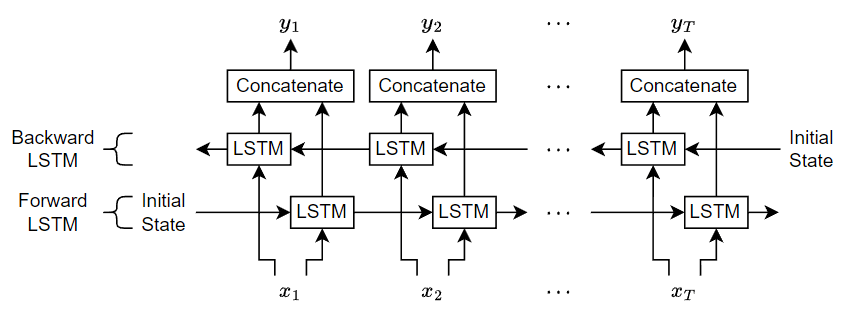Create Bidirectional LSTM (BiLSTM) Function
This example shows how to create a bidirectional long-short term memory (BiLSTM) function for custom deep learning functions.
In a deep learning model, a bidirectional LSTM (BiLSTM) operation learns bidirectional long-term dependencies between time steps of time series or sequence data. These dependencies can be useful when you want the network to learn from the complete time series at each time step.
For most tasks, you can train a network that contains a bilstmLayer object. To use the BiLSTM operation in a function, you can create a BiLSTM function using this example as a guide.
A BiLSTM consists of two LSTM components: the "forward LSTM" that operates from the first time step to the last time step and the "backward LSTM" that operates from the last time step to the first time step. After passing the data through the two LSTM components, the operation concatenates the outputs together along the channel dimension.

Create BiLSTM Function
Create the bilstm function, listed at the end of the example, that applies a BiLSTM operation to the input using the initial hidden state, initial cell state, and the input weights, recurrent weights, and the bias.
Initialize BiLSTM Parameters
Specify the input size (for example, the embedding dimension of the input layer) and the number of hidden units.
inputSize = 256; numHiddenUnits = 50;
Initialize the BILSTM parameters. The BiLSTM operation requires a set of input weights, recurrent weights, and bias for both the forward and backward parts of the operation. For these parameters, specify the concatenation of the forward and backward components. In this case, the input weights have size [8*numHiddenUnits inputSize], the recurrent weights have size [8*numHiddenUnits numHiddenUnits], and the bias has size [8*numHiddenUnits 1].
Initialize the input weights, recurrent weights, and the bias using the initializeGlorot, initializeOrthogonal, and initializeUnitForgetGate functions, respectively. These functions are attached to this example as supporting files. To access these functions, open the example as a live script.
Initialize the input weights using the initializeGlorot function.
numOut = 8*numHiddenUnits; numIn = inputSize; sz = [numOut numIn]; inputWeights = initializeGlorot(sz,numOut,numIn);
Initialize the recurrent weights using the initializeOrthogonal function.
sz = [8*numHiddenUnits numHiddenUnits]; recurrentWeights = initializeOrthogonal(sz);
Initialize the bias using the initializeUnitForgetGate function.
bias = initializeUnitForgetGate(2*numHiddenUnits);
Initialize the BiLSTM hidden and cell state with zeros using the initializeZeros function attached to this example as a supporting file. To access this function, open the example as a live script. Similar to the parameters, specify the concatenation of the forward and backward components. In this case, the hidden and cell state each have size [2*numHiddenUnits 1].
sz = [2*numHiddenUnits 1]; H0 = initializeZeros(sz); C0 = initializeZeros(sz);
Apply BiLSTM Operation
Specify an array of random data with mini-batch size 128 and sequence length 75. The first dimension of the input (the channel dimension) must match the input size of the BiLSTM operation.
miniBatchSize = 128; sequenceLength = 75; X = rand([inputSize miniBatchSize sequenceLength],"single"); X = dlarray(X,"CBT");
Apply the BiLSTM operation and view the size of the output.
Y = bilstm(X,H0,C0,inputWeights,recurrentWeights,bias); size(Y)
ans = 1×3
100 128 75
For models that require only the last time step of the sequence, extract the vectors corresponding to the last output of the forward LSTM and backward LSTM components.
YLastForward = Y(1:numHiddenUnits,:,end); YLastBackward = Y(numHiddenUnits+1:end,:,1); YLast = cat(1, YLastForward, YLastBackward); size(YLast)
ans = 1×3
100 128 1
BiLSTM Function
The bilstm function applies a BiLSTM operation to the formatted dlarray input X using the initial hidden state H0, initial cell state C0, and parameters weights, recurrentWeights, and bias. The input weights have size [8*numHiddenUnits inputSize], the recurrent weights have size [8*numHiddenUnits numHiddenUnits], and the bias has size [8*numHiddenUnits 1]. The hidden and cell state each have size [2*numHiddenUnits 1].
function [Y,hiddenState,cellState] = bilstm(X,H0,C0,inputWeights,recurrentWeights,bias) % Determine forward and backward parameter indices numHiddenUnits = numel(bias)/8; idxForward = 1:4*numHiddenUnits; idxBackward = 4*numHiddenUnits+1:8*numHiddenUnits; % Forward and backward states H0Forward = H0(1:numHiddenUnits); H0Backward = H0(numHiddenUnits+1:end); C0Forward = C0(1:numHiddenUnits); C0Backward = C0(numHiddenUnits+1:end); % Forward and backward parameters inputWeightsForward = inputWeights(idxForward,:); inputWeightsBackward = inputWeights(idxBackward,:); recurrentWeightsForward = recurrentWeights(idxForward,:); recurrentWeightsBackward = recurrentWeights(idxBackward,:); biasForward = bias(idxForward); biasBackward = bias(idxBackward); % Forward LSTM [YForward,hiddenStateForward,cellStateForward] = lstm(X,H0Forward,C0Forward,inputWeightsForward, ... recurrentWeightsForward,biasForward); % Backward LSTM XBackward = X; idx = finddim(X,"T"); if ~isempty(idx) XBackward = flip(XBackward,idx); end [YBackward,hiddenStateBackward,cellStateBackward] = lstm(XBackward,H0Backward,C0Backward,inputWeightsBackward, ... recurrentWeightsBackward,biasBackward); if ~isempty(idx) YBackward = flip(YBackward,idx); end % Output Y = cat(1,YForward,YBackward); hiddenState = cat(1,hiddenStateForward,hiddenStateBackward); cellState = cat(1,cellStateForward,cellStateBackward); end
See Also
sequenceInputLayer | lstmLayer | bilstmLayer | dlarray | lstm
Topics
- Sequence Classification Using 1-D Convolutions
- Sequence-to-Sequence Classification Using 1-D Convolutions
- Sequence Classification Using Deep Learning
- Sequence-to-Sequence Classification Using Deep Learning
- Sequence-to-Sequence Regression Using Deep Learning
- Sequence-to-One Regression Using Deep Learning
- Time Series Forecasting Using Deep Learning
- Long Short-Term Memory Neural Networks
- List of Deep Learning Layers
- Deep Learning Tips and Tricks